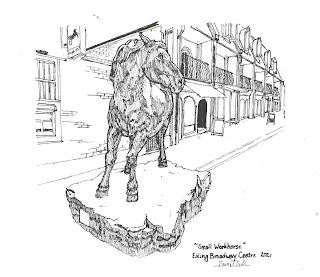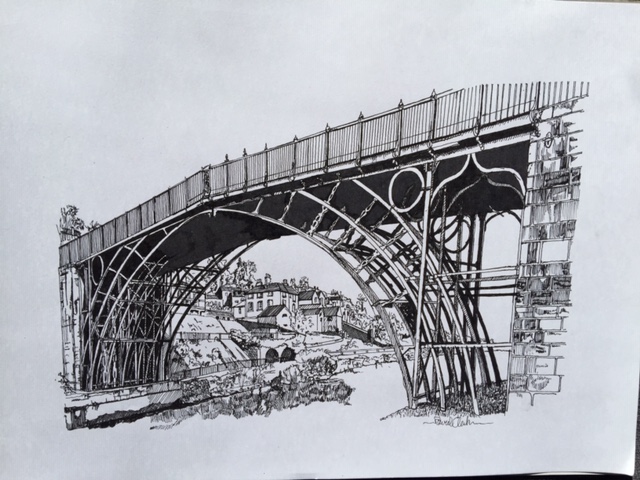Been a while, hasn't it?
Don't worry, I haven't given up sketching. No, I just haven't got round to posting anything. Now, you know the last thing I posted - the sketch of Chester Eastgate? Took me the best part of a day to make, but then I was making these during lockdown and then the summer of 2020 so that didn't really matter, did it.
One of the stories on the news linked to lockdown was the growth of internet shopping. So, looking at my recent beautiful Britain pictures, it occurred to me that maybe this would be a good time to reactivate my Etsy shop. Which I did.
At the dog end of 2019 my oldest daughter, who manages our local Oxfam shop had a small line drawing of Port Talbot donated. It sold almost straightaway. He words to me were "Yours are no worse than that one, Dad. Any chance you'd make a few for the shop?" So I did, we framed them, and blow me, but the half dozen I produced then and there raised several hundred pounds for the shop. This convinced me that there was a market for original sketches and prints of Port Talbot buildings, of the kind that I've been drawing for several years.
 |
| A selection of original sketches made for the Oxfam shop in 2019, and subsequently used for prints in my Etsy Shop |
My original plan was to sell in loval craft fairs. I did quite well in the lead up to Christmas of 2019, but then lockdown came along. So when I revived my Etsy store, amongst the first prints I offered were prints of those pictures I'd sold in the shop - I'd had the good sense to make digital copies of them before framing. Then I posted them on a Port Talbot Facebook group. I didn't post a link to my shop - that sort of thing is discouraged most strongly on Facebook. However, it stimulated a number of comments with people asking me if I sold prints, and then I would message them and give them the link.
Last year, it occurred to me that Ealing, the London Borough where I was born, has a larger population than Port Talbot. So I made a number of sketches of Ealing landmarks, drip fed them onto a couple of Ealing Facebook groups, using the same method I'd used in Port Talbot, and waited for the orders to come in. We're not talking retirement money yet, but and being as it's rude to talk money, I will suffice it to say that it's still a nice source of income.
 |
| Some of the first London Borough of Ealing prints available in my Etsy shop |
Going back to the Port Talbot sketches, the originals in the Oxfam shop were seen by a member of the Friends of Margam Park, Port Talbot's own stately home, now owned by the council and open to the public. They asked me if we could exhibit my Port Talbot sketches. - Yes please! - said I. This was late in 2019. Well, time dragged on in 2020 with nothing happening, and then lockdown happened. So to the time of writing this in 2022, it has sadly not happened.
Likewise, I was invited to discuss the possibility of exhibiting some of my Ealing sketches in the Pitshanger Gallery, but this is currently on hold, maybe until I retire from teaching in a couple of years time.
I would hate you to get the idea that everything I've done in the last couple of years has been just commercial work though. At the start of 2020 I conceived the idea of making sketches of every London Underground station, just for my own pleasure. So I did. Then in the summer, when I finished with the Underground, I drew all of the 145 odd London Overground stations. Then I decided to do the 40+ DLR stations. You'll appreciate that this all slowed down considerably between the two lockdowns and after the second, but I finished the last DLR station just after Christmas 2021.
This forced me to confront an inescapable truth. I rushed the Underground sketches. I took time and trouble over the Overground and DLR sketches and they are much, much better than the Underground ones. Compare them for yourself: -
 |
| this is an Overground sketch |
 |
| and this is a DLR sketch |
while: -
 |
| this is one of my original underground sketches. |
The difference is inescapable. I could have left it as i was, but this really wasn't an option. Originally I was just going to make new drawings of the worst - so I replaced my Ruislip Manor drawing above with this new sketch: -
In the end I produced more than 40 brand new sketches like this. However after the first 20 or so it occurred to me that with a lot of the sketches, the outlines were fine, it was just that the lacked detail and definition, and in some cases I could add these to the digital images with the simple MS Paint programme
 |
| The addition of the brickwork and roof tiling lines via ms paint greatly improved a number of sketches. |
However, although quicker than making new sketches I found the process time consuming and fiddly. And while it worked to add brickwork, it wasn't really a help in adding foreground and background details to give the sketches context. Then it occurred to me that I still had the majority of the original sketches, and it would be a lot quicker and easier to improve these with a pen by hand, than it would to use the PC or to make new sketches. So a sketch like this one: -
could be transformed into something like this:-When I finished the project last week, I'd produced over 40 new sketches, improved about 2 dozen on the PC, left about a dozen as they were, and improved all of the rest by hand. If a job's worth doing . . .























